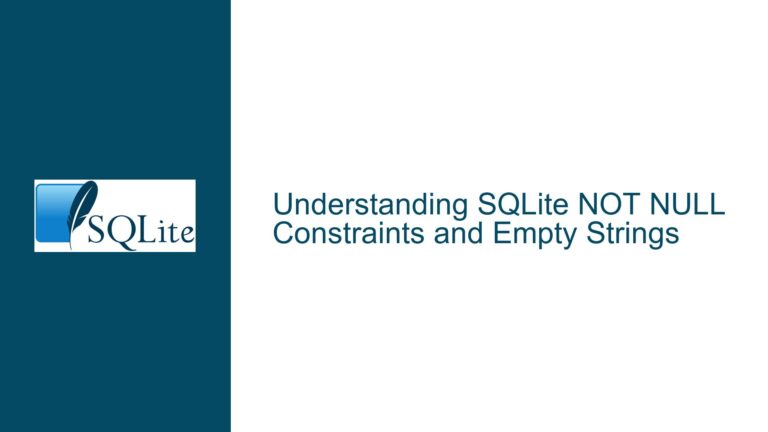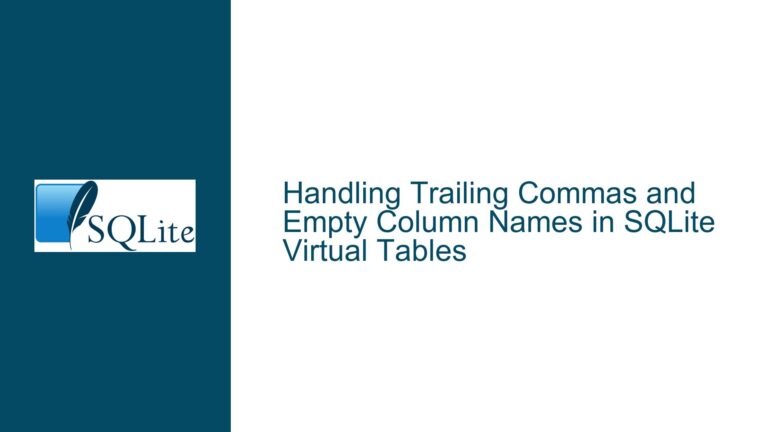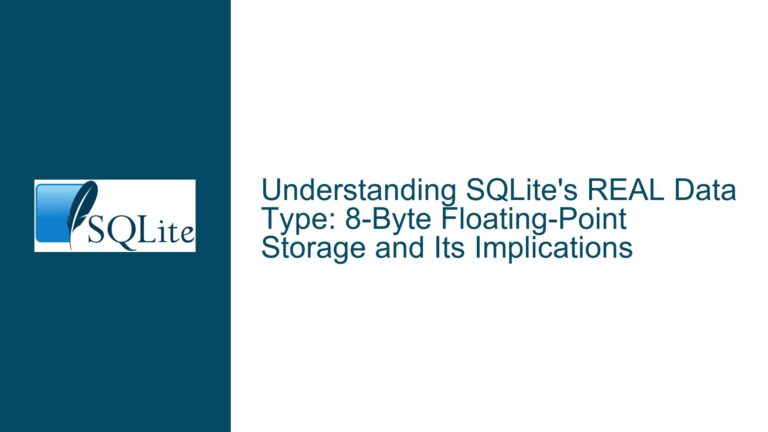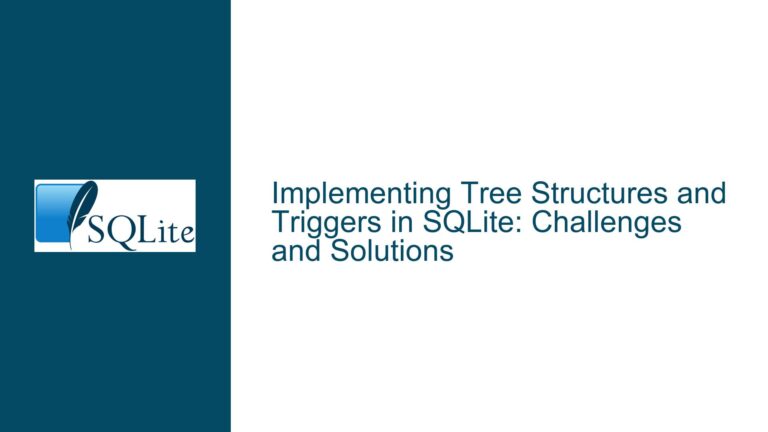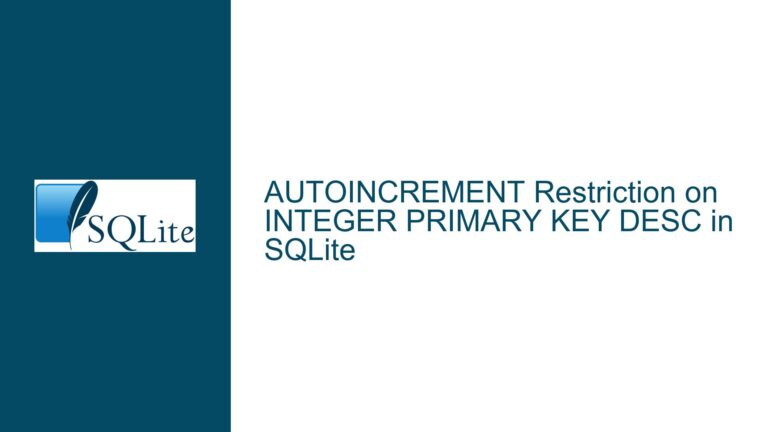Designing a Disk Catalog Program with SQLite: Directory Structure and Query Optimization
Issue Overview: Modeling Directory Structures and File Attributes in SQLite
When designing a disk catalog program using SQLite, one of the primary challenges is effectively modeling the directory structure and file attributes in a way that supports efficient storage, retrieval, and querying. The core issue revolves around how to represent directories and their relationships with files, particularly when dealing with hierarchical structures and recursive searches. The two main approaches discussed are:
Storing Full Paths in a Single Table: This approach involves storing the complete file path as a text column in the
Filetable. While simple to implement, it raises concerns about redundancy, storage efficiency, and the ability to handle dynamic changes in directory structures.Separate Directory and File Tables with Parent-Child Relationships: This approach involves creating a
Directorytable where each directory is represented as a row with a unique ID and a reference to its parent directory. TheFiletable then links to theDirectorytable via a foreign key. This method is more normalized and flexible but introduces complexity in querying and maintaining hierarchical relationships.
The choice between these approaches depends on the specific requirements of the application, such as the need for dynamic updates, the scale of the data, and the types of queries that will be performed. Additionally, considerations like handling multiple devices (e.g., USB drives) and ensuring unique identification of files across different storage locations add further complexity to the design.
Possible Causes: Trade-offs and Challenges in Directory Modeling
The challenges in modeling directory structures and file attributes in SQLite stem from several factors:
Storage Efficiency vs. Query Complexity: Storing full paths in the
Filetable is straightforward and minimizes the number of tables required. However, it can lead to redundant data, especially when many files share the same directory path. On the other hand, using a separateDirectorytable with parent-child relationships reduces redundancy but increases the complexity of queries, particularly when performing recursive searches for files within a directory and its subdirectories.Handling Dynamic Changes: If the directory structure is expected to change frequently (e.g., directories being renamed or moved), the normalized approach with a
Directorytable is more flexible. It allows for easier updates to directory names and relationships without affecting theFiletable. In contrast, storing full paths requires updating every affected file entry when a directory is renamed or moved.Cross-Device Cataloging: When cataloging files from multiple devices (e.g., USB drives, network shares), ensuring unique identification of files becomes critical. Using a
deviceIDfield in addition to the directory and file information helps distinguish between files with identical paths on different devices. This adds another layer of complexity to the schema design.Recursive Query Performance: Searching for all files within a directory and its subdirectories is a common requirement. The normalized approach requires recursive queries or common table expressions (CTEs) to traverse the directory hierarchy, which can be computationally expensive. Storing full paths allows for simpler pattern-matching queries but may not be as efficient for large datasets.
Data Integrity and Normalization: The normalized approach with separate
DirectoryandFiletables adheres to database normalization principles, reducing redundancy and improving data integrity. However, it requires careful management of foreign key relationships and may involve more complex joins in queries.
Troubleshooting Steps, Solutions & Fixes: Optimizing Directory and File Modeling in SQLite
To address the challenges and trade-offs in modeling directory structures and file attributes in SQLite, the following steps and solutions can be implemented:
1. Schema Design for Directory and File Tables
Option A: Separate Directory and File Tables
Directory Table: Create a
Directorytable with columns fordirectoryID(primary key),directoryName, andparentDirectoryID(foreign key referencingdirectoryID). This table represents the hierarchical structure of directories.CREATE TABLE Directory ( directoryID INTEGER PRIMARY KEY, directoryName TEXT NOT NULL, parentDirectoryID INTEGER, FOREIGN KEY (parentDirectoryID) REFERENCES Directory(directoryID) );File Table: Create a
Filetable with columns forfileID(primary key),fileName,fileSize,fileModifiedTime, anddirectoryID(foreign key referencingDirectory).CREATE TABLE File ( fileID INTEGER PRIMARY KEY, fileName TEXT NOT NULL, fileSize INTEGER, fileModifiedTime DATETIME, directoryID INTEGER, FOREIGN KEY (directoryID) REFERENCES Directory(directoryID) );
Option B: Full Paths in File Table
File Table: Create a
Filetable with columns forfileID(primary key),filePath(full path including directory),fileSize, andfileModifiedTime.CREATE TABLE File ( fileID INTEGER PRIMARY KEY, filePath TEXT NOT NULL, fileSize INTEGER, fileModifiedTime DATETIME );
2. Handling Multiple Devices
To support cataloging files from multiple devices, add a deviceID column to the File table (and optionally to the Directory table if using the normalized approach). This column can store a unique identifier for each device, such as the volume label or UUID.
ALTER TABLE File ADD COLUMN deviceID TEXT;
3. Recursive Queries for Hierarchical Data
For the normalized approach, use recursive common table expressions (CTEs) to query files within a directory and its subdirectories.
WITH RECURSIVE Subdirectories AS (
SELECT directoryID FROM Directory WHERE directoryID = ?
UNION ALL
SELECT d.directoryID
FROM Directory d
INNER JOIN Subdirectories s ON d.parentDirectoryID = s.directoryID
)
SELECT f.*
FROM File f
JOIN Subdirectories s ON f.directoryID = s.directoryID;
For the full path approach, use pattern matching with the LIKE operator.
SELECT * FROM File WHERE filePath LIKE ? || '%';
4. Optimizing Query Performance
Indexing: Create indexes on frequently queried columns, such as
directoryIDin theFiletable andparentDirectoryIDin theDirectorytable.CREATE INDEX idx_file_directoryID ON File(directoryID); CREATE INDEX idx_directory_parentDirectoryID ON Directory(parentDirectoryID);Caching: For frequently accessed directory structures, consider caching the results of recursive queries or maintaining a materialized view of the directory hierarchy.
5. Handling Dynamic Changes
For the normalized approach, updating directory names or moving directories involves updating the Directory table and ensuring that all related File entries remain consistent.
UPDATE Directory SET directoryName = ? WHERE directoryID = ?;
For the full path approach, updating directory names requires updating the filePath column for all affected files.
UPDATE File SET filePath = REPLACE(filePath, ?, ?) WHERE filePath LIKE ? || '%';
6. Data Integrity and Validation
Foreign Key Constraints: Ensure that foreign key constraints are enforced to maintain referential integrity between the
DirectoryandFiletables.Triggers: Use triggers to automatically update related entries when directories are renamed or moved.
CREATE TRIGGER update_file_paths AFTER UPDATE ON Directory
FOR EACH ROW
BEGIN
UPDATE File SET filePath = REPLACE(filePath, OLD.directoryName, NEW.directoryName)
WHERE filePath LIKE OLD.directoryName || '%';
END;
7. Alternative Approaches and Tools
Consider using existing tools or libraries that simplify hierarchical data management in SQLite, such as the Vault3 program mentioned in the discussion. These tools often provide built-in support for tree structures and recursive queries, reducing the need for custom implementations.
Conclusion
Designing a disk catalog program with SQLite involves careful consideration of how to model directory structures and file attributes. The choice between storing full paths and using a normalized approach with separate tables depends on the specific requirements of the application, including the need for dynamic updates, query performance, and data integrity. By following the steps and solutions outlined above, you can create a robust and efficient schema that meets the needs of your disk catalog program.

